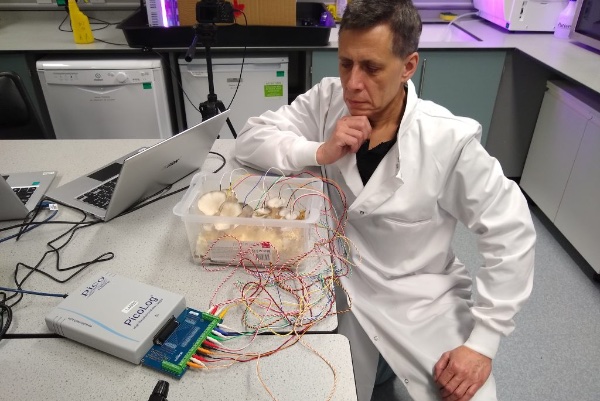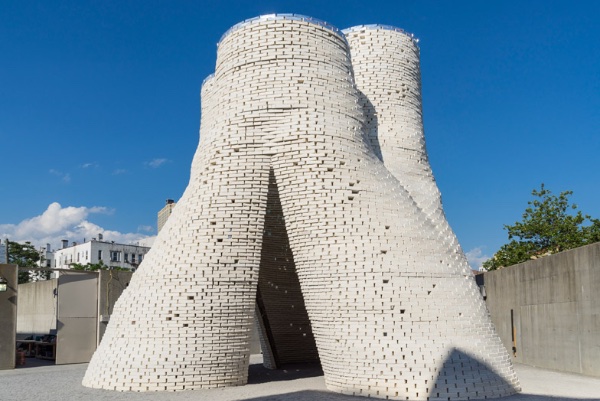ISABEL RUBIO ARROYO | Tungsteno
Scientists are still debating the origin and even the evolution of the biological kingdom of fungi, whose presence, according to the latest findings, dates back more than 800 million years. Partners of the first plants to colonise the Earth's surface, it has now also been shown that these organisms have the potential to react to multiple stimuli. In fact, "they can sense everything we humans sense and undoubtedly much more," says Antoni Gandía, a specialist in fungal research and development and biotechnology. This unique ability raises the possibility of utilising these organisms for such surprising uses as creating gadgets, wearables and even smart buildings.
Recent research carried out by the University of the West of England (Bristol), Mogu, the Italian Institute of Technology and the Universitat Oberta de Catalunya has confirmed that these organisms have sensory properties and are able to process various external stimuli such as light, deformations, temperature, the presence of chemicals and even electrical signals. Gandía, who is one of the authors of this study, indicates that fungi can also sense the pressure exerted by the weight of an object, "for example, when we step on the forest floor."
Smart clothing with patches of living tissue
Harnessing these capabilities for other uses, from embedding them into wearable devices to using them as a building material, is the path currently being explored in research. "The application of living fungi in wearables or portable technological objects is a concept that we have started to dream about and that is just now entering the development phase, so it may take years or decades before we see functional gadgets," Gandía acknowledges.
But to what extent can fungi actually be used to develop wearables or other devices? His team will begin measuring this year the fungi's sensitivity to human hormones and trace chemicals in the air. The aim is to see if these organisms can help discern a person's state of health or the presence of hazardous gases or materials nearby. "In the short term, we could be wearing little patches of living tissue on our T-shirts that help us monitor all these parameters as well as environmental conditions," he foresees.

Capable of processing information, fungi could monitor external stimuli such as light, deformations, temperature and even the presence of chemicals. Credit: FUNGAR.
Living inside a fungus
While it remains to be seen whether such applications will become a reality, there are already several examples of fungal architecture in the world, that is, structures built with biomaterials from fungi. A number of companies are making construction and packaging elements from the mycelium—the set of filaments that form the vegetative part of a fungus —of these organisms. For example, Mogu creates heat and sound insulation panels, flooring and decorative pieces from mushrooms. The company Ecovative Design, which produces solid blocks from mycelium and hemp fibres, has made a prototype house from these organisms that has served as an example of the multiple applications of these fungal materials.
Although most of the applications available on the market are those related to inert mycelium, living fungi are also being experimented with in the construction sector. The European FUNGAR project aims to create a full-scale fungal building in Denmark and Italy, as well as a smaller scale version at the University of the West of England. This structure is intended to be built with living mycelium capable of interacting with its tenants and self-regulating environmental parameters such as temperature, lighting and humidity in its rooms.
"Living inside a fungus seems a bit strange, but why is it so strange to think that we could live inside something living?" says UOC researcher Mohammad Mahdi Dehshibi. For him, it would be a rather interesting ecological movement that would make it possible to dispense with concrete, glass and wood. "Think of schools, offices and hospitals that are growing, regenerating and dying; it's the pinnacle of sustainable living," he says.

Mushrooms are already used to make building materials and have been tested to erect structures. The goal is to create sustainable buildings capable of self-regulation. Credit: MOMA.
Optimising transport and fighting climate change
Initially, it would be possible to use multiple species of filamentous fungi, but Gandía says the favourites are those that produce a dense mycelium that is resistant to mechanical forces. An example is polypores: "Polyporous fungi are easy to identify in nature, as they are those fungi that form hard, durable mushrooms that take a long time to decompose and resemble wood to the touch."
We may have to wait for some time to see how far the potential of live fungi, whose applications are beginning to multiply, can be realised. In fact, experiments are already underway with slime moulds navigating labyrinths in laboratories and connecting dots on a map as efficiently as possible. This, Gandía suggests, could improve the design of urban transport and telecommunications networks. These organisms could even provide some clues to tackling climate change: "Thanks to ongoing research, in a few years we could connect with the mycelial networks in our soils to know and monitor the state of health of ecosystems."
· — —
Tungsteno is a journalism laboratory to scan the essence of innovation. Devised by Materia Publicaciones Científicas for Sacyr’s blog.
